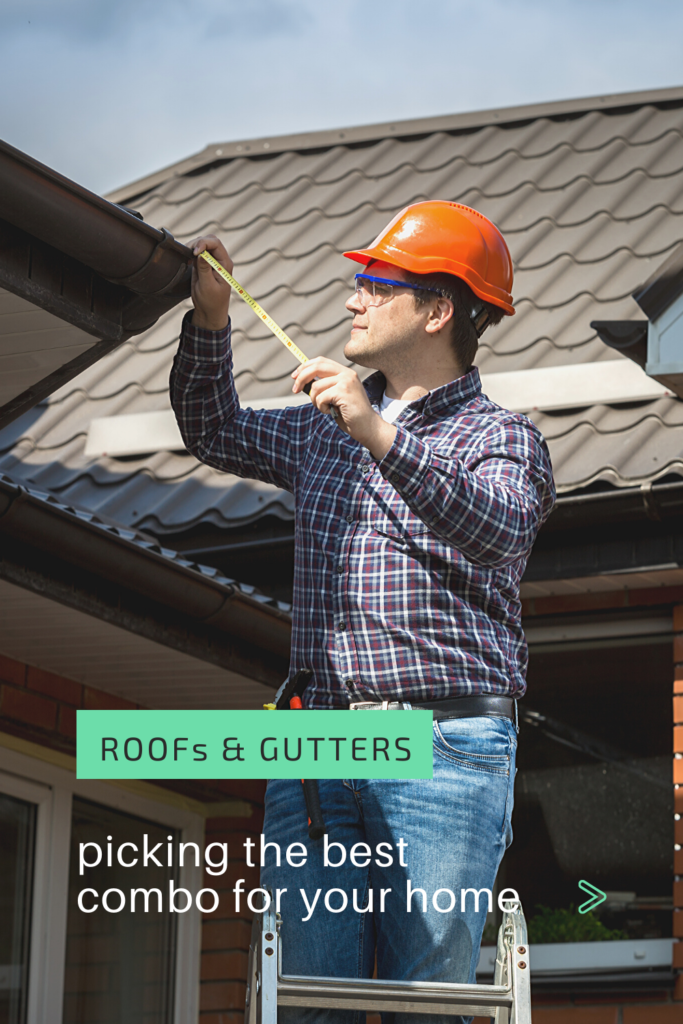A roof is a large part of your home’s appearance. It accentuates the exterior features and architectural design while protecting the home from various weather conditions. Both roofs and gutter systems come in a variety of shapes, sizes, and materials. When selecting the right combination for your future home, there are several important things to consider when it comes to roofs and gutters.

Purpose of Roofs and Gutters
The function of gutter systems and roofs is to protect the home from storms and weather, so water doesn’t cause any damage like rust, rot, mold, or worse. Water must slide off the roof, through the gutter system, and into the yard or sewage drains.
Gutters help preserve the integrity of your home’s roof and protect other parts of the house, like the walls and foundation, by diverting water away from it. The shape of the roof determines the design of the home’s gutter system. Poor design and installation for either the roof or the gutter system can lead to damage or erosion of the roof and clogs in the gutters.
Location of the Home
The location of the home refers to the region or state in which you live. This largely influences the best roof and gutter system for homes because of the various weather conditions that come with living in certain regions. For example, mild climates that do not see a lot of precipitation often have flatter roofs, and the quality of the gutter systems is less important.
On the other hand, homes that are in regions that experience rain, snow, hail, or other forms of inclement weather tend to have steeper roofs and extensive gutter systems. Luckily, selecting the appropriate roof and gutter system for the region in which you live is fairly straightforward because local roofing and gutter companies specialize in the shapes and material for the area.
Shape of the Roof
The location of your home largely influences the shape of its roof. The roof design must also be appropriate for the home’s structure and architectural design. There are a variety of roof shapes that are common throughout the U.S. that you can select from when building your home. The following is a list of common roof shapes and the types of gutter systems required for home efficiency.
- Hip roof: This pyramid-like design gently slopes down to the walls of the home without any other vertical sides to the design. In other words, all the home’s sides sit under each side of the roof. A hip roof needs gutters around the entire perimeter to effectively move water away from the roof and house.
- Double gable roof: This design is classified by two sloping sides that come together in a ridge, creating end walls. Typically, this roof extends to a triangular shape and often frames a window. Double gable roofs require end gutters on two sides of the roof that come together to make a rectangle.
- A-frame roofs: The roofs are popular in highly elevated and/or forested areas. A-frame roofs are giant gables with each side of the triangle extending to the bottom of the home’s foundation. These roofs require minimal gutter systems – downspouts along each side is all. If the home is an area with little precipitation, it may not require any gutters at all.
- Metal/stone coated steel roofs: These roofs are popular because they are believed to have longevity; however, the lack of friction affects how water flows off coated steel roofs. The speed and velocity that the water travels make it difficult for any gutter system to capture the water. In regions with a lot of rain or snow, this leads to wear and tear on gutter channels and downspouts.
Other common exterior elements to the home are dormers. A dormer is a structure that protrudes from the home, usually containing a window. When dormers are included in the structure of the home, additional gutters are required, so water does not erode the shingles.
Materials of the Roof and Gutter System
A home’s roof and gutter system are only as durable as the materials from which they are made. The
biggest indicator of the price is the materials. When selecting materials for both the roof and gutters, homeowners should make sure that they are compatible and will hold up in the area’s expected weather conditions.
Gutter systems come in a variety of different materials, including vinyl, aluminum, steel, copper, and stainless steel. Aluminum gutter systems are common because they are lightweight, rust-proof, and easy to install, while also holding up well in most weather conditions. Steel and copper gutters are the sturdiest options, but neither steel nor copper is rust-proof. These materials are also the most expensive to install. A professional gutter installation service can advise homeowners on the most appropriate material for their gutters based on the weather conditions in the area, as well as the structure of the roof. Homeowners have many options when selecting a material for their roofs, such as asphalt, metal, wood, clay or concrete tile, slate, and many more. Most are of sound quality, so builders normally recommend materials based on appearance and compatibility with the home’s exterior.